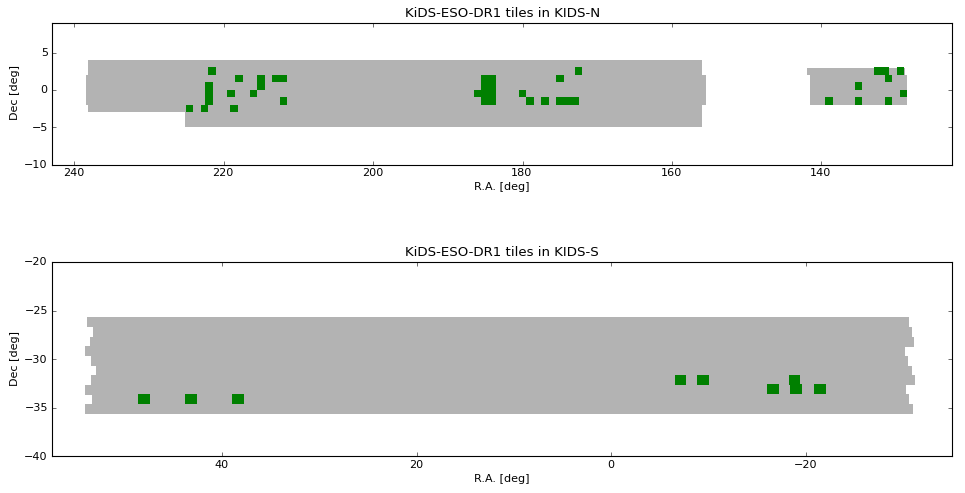Data Release Content
Included tiles
This first public data release of KiDS is based on the first 50 tiles that were observed in all 4 filters (u,g,r,i), during the first year of survey operations (15 October 2011 to 30 September 2012). The locations of these 50 tiles on the sky are indicated in the figure below. For a table with the coordinates of the tile centers please refer to the data table on this website.

|
|
Location of the 50 KiDS-ESO-DR1 tiles; the two KiDS fields (top: KiDS-North; bottom: KiDS-South) are outlined in gray, with the tiles included in this data release in green. |
Data products
The following types of data products are provided in this data release:
- Coadds: photometrically and astrometrically calibrated, stacked images (1 per filter per tile)
- Weights: weight frames (1 for each Coadd)
- Flag images: FITS images with pixel flags in areas affected by bright stars, saturated pixels, reflections, and other artefacts (1 for each Coadd)
- Source lists: lists of sources detected in single Coadds
A total of 800 files is included in the official data release: per tile for each filter a Coadd, a corresponding weight frame, a mask FLAG image, and a source list; the total data volume is 702 GB. Via this website, additional source lists (using different source detection parameters) and inspection plots are accessible.
Naming convention
The naming convention used for all data products is the following:
KiDS_DR1.0_R.R_D.D_F_TTT.fits,
where R.R and D.D are the RA and DEC of the tile center in degrees (J2000.0) with 1 decimal place, F is the filter (u, g, r, or i), and TTT is the data product type. The value of TTT for the different data products is given in column 4 of the table below.
For example: the r-band stacked image of the tile “KIDS_48.3-33.1” is called KiDS_DR1.0_48.3_-33.1_r_sci.fits.
Data format
The final calibrated, coadded images have a uniform pixel scale of 0.2 arcsec. The pixel units are fluxes relative to the flux corresponding to magnitude = 0. This means that the effective zeropoint is equal to 0 and the magnitude m corresponding to a pixel value f is:
m = -2.5 log10 f.
The following table lists the types of data products provided in this release, together with descriptions of the file types and naming conventions used.
| Data product | ESO product category name | File type | TTT |
|---|---|---|---|
| Calibrated, stacked images | SCIENCE.IMAGE | FITS image | sci |
| Weight frames | ANCILLARY.WEIGHTMAP | FITS image | wei |
| Masks | ANCILLARY.MASK | FITS image | msk |
| Single-band source lists | SCIENCE.SRCTBL | Binary FITS table | src |
